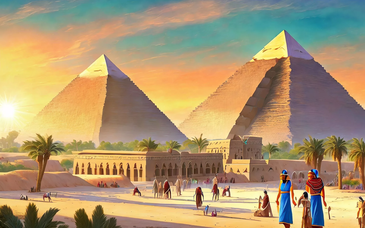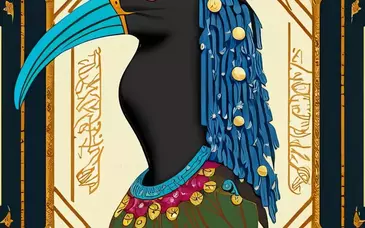README Aegyptische Wortliste (GM 140, 1994, S. ...)
"Habent sua fata libelli ...". Auch die hier angekuendigte
Wortliste hat ihre Geschichte. Urspruenglich war nur
beabsichtigt, fuer den Privatgebrauch den aegyptischen
Grundwortschatz auf EDV-Basis verfuegbar zu haben. Die Vorteile
dabei werden jedem einleuchten, der mit EDV arbeitet: Man kann
etwa Woerter nach verschiedenen Gesichtspunkten sortieren, nach
bestimmten Wortstrukturen suchen; man hat eine Hilfe bei der
Ergaenzung zerstoerter Textstellen und bei der Lesung unklarer
Zeichen im Wortzusammenhang. Eine solche Wortliste kann auch als
Basis fuer einen Thesaurus dienen u.a.m. (vgl. Seidlmayer, in:
GM 128, 1992, S. 28).
Nachdem einmal auf der Grundlage des Woerterbuches der aegyptischen
Sprache Bd. 7 eine solche Wortliste erstellt und zur Probe ausgedruckt
war, zeigte sich, dass man die Liste auch sehr schoen als
Taschenwoerterbuch bei Museumsbesuchen und Aegyptenaufenthalten als
Gedaechtnisstuetze mit sich tragen konnte. Dass daraus die
Ueberlegung einer weiteren Verbreitung einer solchen Wortliste in Form
eines kleinen Taschenwoerterbuches entstand, duerfte naheliegen.
In diesem Stadium war daran gedacht, das "Taschen-Wb" aehnlich
der Stichwortliste des LAe (LAe VII, S. 741-828) mehrsprachig
anzulegen. Einige Kollegen, denen an dieser Stelle herzlich
gedankt sei, hatten sich auch schon dazu bereit erklaert, die
deutschen Bedeutungsangaben in das Englische, Franzoesische und
Italienische zu uebertragen. Weiter war daran gedacht, auch das
Arabische zu beruecksichtigen. Darueberhinaus sollte dem Buch eine
Diskette mit der Datei beigefuegt sein.
Diese Idee eines solchen polyglotten Taschen-Woerterbuches wurde
dem Akademie-Verlag vorgestellt, der an der Verwirklichung
zunaechst auch interessiert war, dann aber nach Ueberpruefung der
wirtschaftlichen Seite wieder davon Abstand nahm. Als sich
zeigte, dass eine gedruckte Realisierung zu einem erschwinglichen
Preis nicht moeglich war, blieb nur die Moeglichkeit der
Publikation auf EDV-Basis.
Inzwischen war die urspruengliche Wortliste um etwa 15% erweitert
worden: Hinzugekommen waren Woerter, die im alten Woerterbuch der
aegyptischen Sprache nicht aufgenommen waren, aber in Listen wie
Meeks: Annee lexicographique, RdE 29 und 30 und Cerny: Coptic
Etymological Dictionary als Nachtraege zum Wb gekennzeichnet
waren. Ohne Vollstaendigkeit anzustreben, sind gelegentlich
weitere lexikographisch relevante Publikationen beruecksichtigt
worden.
Die oben genannten Gruende haben uns, nachdem eine gedruckte,
EDV-unterstuetzte Fassung nicht mehr realisierbar war, dazu
bewogen, die aegyptische Wortliste in ihrer gegenwaertigen Form
interessierten Kollegen unentgeltlich zur Verfuegung zu stellen
und zugleich einen Austausch von derartigen Hilfsmitteln
anzuregen, wie sie durch EDV moeglich sind.
Unsere Datei ist so gegliedert, dass in einer Zeile jeweils das
aegyptische Wort in Umschrift, die Bedeutungsangabe und der
Verweis auf das Woerterbuch bzw. die genannten Listen zu finden
sind.
Die Woerter sind nach dem aegyptologischen Umschriftalphabet
geordnet, wobei z und s bei der Anordnung wie in Faulkner:
Concise Dictionary nicht unterschieden werden. Bei der Kom-
binierung der Daten, die auf das Woerterbuch zurueckgehen, und
derer, die aus den Nachtragslisten stammen, mussten gewisse
Inkonsequenzen in Kauf genommen werden. So stehen anstelle von j
und jj auch i und y. Die Transkription verwendet bei den
Nachtraegen statt z stets s. Natuerlich besteht in der Datei die
Moeglichkeit zur individuellen Anpassung. Unser Angebot kann sich
selbstverstaendlich nur auf die reinen Daten der Wortliste
beziehen. Textverarbeitungsprogramme dazu koennen und wollen wir
nicht anbieten. Jeder einzelne muss wissen, ob und wie er die
Wortliste (ASCII-Datei von ca. 0,8 MB) verarbeiten kann. In
Wuerzburg benutzen wir dazu das "Tuebinger System von
Textverarbeitungs-Programmen (TUSTEP)" des Zentrums fuer
Datenverarbeitung der Universitaet Tuebingen.
Wir koennten uns vorstellen, dass Aegyptologen anderer
Muttersprachen die vorgelegte Liste als Grundlage fuer ein
eigenes Woerterbuch verwenden koennen. Soweit uns Rechte an den
wie beschrieben gesammelten Daten zustehen, ueberlassen wir sie
Fachkollegen zur ausschliesslich privaten Nutzung. Vielleicht ist
dies auch eine Anregung fuer andere, ihrerseits entsprechende
Hilfsmittel ohne grosse Kosten an interessierte Kreise weiter-
zugeben. Dankbar waeren wir ueber korrigierende und ergaenzende
Hinweise. Es waere schoen, wenn uns auch Uebersetzungen der Liste
in andere Sprachen zugaenglich gemacht wuerden, so dass vielleicht
eines Tages einmal ein polyglottes "Taschen-Wb" entsteht.
Die Verbreitung unserer Datei (wie gesagt, eine ASCII-Datei von
ca. 0,8 MB) sollte so unkompliziert wie moeglich erfolgen. Am
einfachsten ist dies ueber e-mail. Kollegen sollten uns also ihre
e-mail-Adresse mitteilen. Zweckmaessigerweise sollten sich dabei
mehrere Interessenten zusammenschliessen. Eine von Wuerzburg
unabhaengige Weiterverteilung waere in unserem Sinne. Falls keine
e-mail-Adresse vorhanden ist, kann man die Daten auf Anfrage
auch nach Zusendung einer 3 1/2" HD-Diskette (formatiert u.
virenfrei!) an die unten angegebene Adresse erhalten. Bitte
senden Sie uns in diesem Fall auch einen fertig adressierten
Briefumschlag, Sie ersparen uns damit Zeit und Muehe.
Horst Beinlich, Friedhelm Hoffmann
Institut fuer Aegyptologie
der Universitaet Wuerzburg
D-97070 Wuerzburg
Residenzplatz 2 - Tor A
HINWEISE ZUR BENUTZUNG:
Struktur eines Dateisatzes:
@ Wort in Umschrift & Uebersetzung !! Belegstelle !! Uebersetzung
Die Kodierung der UMSCHRIFT folgt den internationalen
Konventionen fuer EDV-Eingaben (s. Informatique et Egyptologie 2,
1988).
UMLAUTE sind - anders als in dieser Datei "wbreadme" - ersatzweise
kodiert als ^ + Buchstabe (z. B. ^a). Entsprechend ist das
"German s" ("sz") als ^s, nicht als ss kodiert (z.B. Ma^s, nicht
Mass).
Die Ersatzkodierung fuer AKZENTE wird durch % eingeleitet; z. B.
K%/akosy, Cl%\ere, %>Cern%/y fuer Kakosy, Clere und Cerny mit
den entsprechenden Akzenten.
Je nach Moeglichkeit der verwendeten Computerprogramme koennen diese
Codierungen individuel veraendert werden.
(Note on the ENGLISH translation:
Please note that web tools and a German to English text file
were used to translate the German into English, so its not perfect.
Keep in mind, that since the AE translation goes to German then to
English, some information and nuances can be lost.
Beachten Sie bitte, da� Web-Hilfsmittel und eine Deutsch-Englische
Textdatei benutzt wurden, um den Deutschen ins Englische zu
�bersetzen, so sein nicht vollkommenes.
-Chris Busch cgbusch@yahoo.com)
README Egyptian word list (GM 140, 1994, S....)
"Habent sua fata libelli...". Also the word list announced here has
its history. Originally was only intended to have for the
privatgebrauch the Egyptian basic vocabulary on EDP basis available.
The advantages thereby will be clear to everyone, which works with
EDP: One can sort, for certain word structures look for for instance
words according to different criteria; one has an assistance with the
addition of destroyed passages in the text and with the reading of
unclear indications in the word connection. Such a word list can
serve also as basis for a thesaurus etc. (see Seidlmayer, in: GM 128,
1992, P. 28).
After once on the basis of the dictionary of the Egyptian language
Bd. 7 such a word list was printed out to the sample provided and, it
showed up that one could carry the list also very beautifully as
pocket dictionary with museum attendance and Egypt stays as memory aid
with itself. The fact that from it the consideration of a further
spreading of such a word list in form of a small pocket dictionary
developed might be obvious.
In this stage was remembered to put on "bag stock" similarly the
keyword list of the LAe (LAe VII, P. 741-828) in several languages.
Some colleagues, here was cordially thanked who, had already explained
themselves ready for it, the German meaning meanings into English to
transfer French and Italian. Further was remembered to consider also
the Arab. In addition the book a disk with the file should be
attached.
This idea of such a polyglotten pocket dictionary the academy
publishing house presented, which was first also interested in the
implementation, then however after examination of the economic side
again of it distance took. When it showed up that a printed
realization was not possible at a reasonable price, only the
possibility of the publication on EDP basis remained.
In the meantime the original word list had been extended by
approximately 15%: Had been added words, which were not taken up in
the old dictionary of the Egyptian language, but into lists such as
Meeks: Annee lexicographique, RdE 29 and 30 and Cerny: Copilot TIC
Etymological Dictionary as Nachtraege to the stock were characterized.
Without aiming at completeness, occasionally further lexicographical
relevant publications were considered.
The reasons specified above have available us, after a printed,
EDP-supported version was no longer realizable, to it induced, free of
charge to place the Egyptian word list in her present form interested
colleague and to energize at the same time an exchange of such aids,
how they are possible by EDP.
Our file is in such a way arranged that in a line the Egyptian word in
transcription, the indication of meaning and the reference to the
dictionary and/or the lists mentioned are to be found in each case.
The words are arranged according to the Egyptological transcription
alphabet, whereby z and s during the arrangement as in Faulkner:
Concise Dictionary not to be differentiated. During combining the
data, which decrease/go back to the dictionary, and those, which
originate from the supplementary lists, certain Inkonsequenzen had to
be taken in purchase. Thus also i and y. the transcription stand used
with the Nachtraegen instead of z for s. natural always exist in the
file the possibility for the individual adjustment in place of j and
jj. Our offer can refer naturally only to the pure data of the word
list. Text processing programs for it can want and we not to offer.
Each particular must know whether and how he can process the word list
(ASCII file of approx. 0.8 MT). In peppering castle we use for it the
"Tuebinger system of text processing programs (TUSTEP)" of the center
for data processing of the University of T�bingen.
We could imagine that Aegyptologen of other native languages can use
the submitted list than basis for their own dictionary. As far as
rights at the as described collected data are entitled to us, we leave
them to professional colleagues for excluding private use. Perhaps
this is also a suggestion for other to pass for their part appropriate
aids on without large costs to interested circles. We would be
grateful over correcting and supplementing references. It would be
beautiful, even if us translations of the list were made accessible
into other languages, so that perhaps a daily once a polyglottes "bag
stock" develops.
The spreading of our file (as said, a ASCII file by approx. 0.8 MT)
should take place as uncomplicatedly as possible. This is simplest
over email. Colleagues should communicate thus their email address to
us. Appropriately thereby several prospective customers should unite.
A far distribution independent of peppering castle would be in our
sense. If no email address is present, one knows the data on request
also after forwarding of a 3 1/2"hp disk (u formats. virus-free!)
receive to the address indicated down. Please you send us in this
case also a finished addressed envelope, you save us thereby time and
trouble.
Refuge Beinlich, Friedhelm hoping man
Institut for Aegyptologie of the University of peppering castle
D-97070 peppering castle residence place 2 - gate A
REFERENCES TO THE USE:
Structure of a file set: @ word in transcription & translation!!
Voucher place
Coding the TRANSCRIPTION follows the international conventions for EDP
inputs (s. Informatique et Egyptologie 2, 1988). UMLAUTS are -
differently than in this file "wbreadme" - as a substitute coded as ^
+ letter (e.g. ^a). The "German s" ("sp") is accordingly as ^s, not
when ss codes (e.g. Ma^s, not measure). The spare coding for ACCENTS
is introduced by %; z. B. K%/akosy, Cl%\ere, %>Cern%/y for Kakosy,
Clere and Cerny with the appropriate accents. Depending upon
possibility of the used computer programs these codings can be changed
individuel.
File.txt



